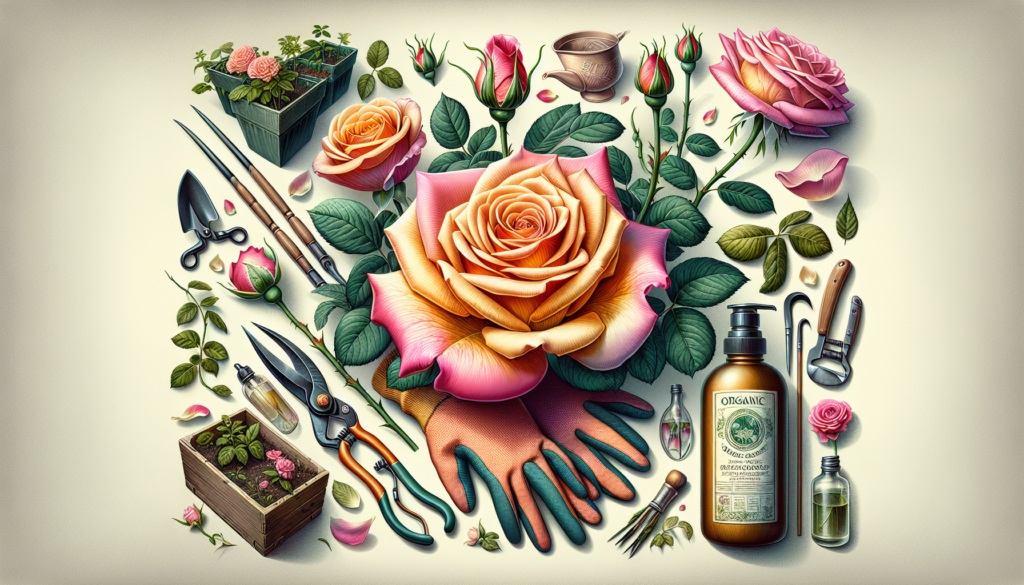If you’ve ever dreamed of having a picturesque garden filled with vibrant and fragrant roses, then look no further. This detailed guide on growing and caring for roses will provide you with all the essential information to turn your dreams into a reality. From selecting the right type of roses to choosing the perfect spot for planting, this article will guide you through every step of the process. So grab your gardening tools and get ready to embark on a delightful journey of nurturing these timeless beauties!

Choosing the Right Roses
When it comes to choosing roses for your garden, there are a few factors to consider. The first is the location and climate of your garden. Roses thrive in sunny spots, so choose a location that receives at least six hours of direct sunlight each day. Additionally, consider your climate and choose roses that are suitable for your region. Some varieties are more heat tolerant, while others are better suited for cooler climates.
Next, it’s time to think about the specific rose varieties you want to plant. There are countless rose varieties to choose from, each with its own unique characteristics. Think about the colors you prefer, as well as the size and shape of the blooms. Do you like fragrant roses? If so, be sure to choose varieties known for their scent. Take the time to research different varieties and read reviews from other gardeners to find the roses that suit your preferences.
Once you have narrowed down your options, it’s time to purchase your rose plants. Look for healthy plants with strong stems and vibrant foliage. Avoid plants that show signs of disease or pest damage. If possible, choose potted roses over bare-root roses, as potted plants tend to establish themselves more quickly. Remember, healthy plants are the foundation for successful rose gardening.
Preparing the Soil
Before planting your roses, it’s important to prepare the soil properly. Start by testing the soil composition to determine its pH level and nutrient content. Roses prefer slightly acidic soil with a pH between 6.0 and 6.5. If your soil is too alkaline, you can amend it by adding sulfur or peat moss to lower the pH. On the other hand, if your soil is too acidic, you can raise the pH by adding lime or wood ash.
In addition to adjusting the pH, it’s important to ensure that your soil has good drainage. Roses do not like to sit in waterlogged soil, as it can lead to root rot. If your soil doesn’t drain well, you can improve it by adding organic matter such as compost or well-rotted manure. This will help improve both the texture and drainage of the soil.
Planting Roses
Once your soil is ready, it’s time to plant your roses. Start by selecting the planting site. Choose an area with enough space to accommodate the size of your roses at full maturity. Roses need plenty of air circulation to prevent diseases, so avoid planting them too close to walls or other plants.
When digging the planting hole, make sure it is wide and deep enough to accommodate the rose’s root system. Loosen the soil at the bottom of the hole to allow the roots to penetrate easily. Before placing the rose in the hole, prune any damaged or overcrowded roots to encourage healthy growth.
Proper spacing and positioning are crucial when planting roses. Give each rose enough space to grow without being crowded by neighboring plants. Leave at least 2-3 feet of space between each rose to allow for air circulation. Additionally, make sure the bud union (the swollen area where the rose was grafted onto the rootstock) is level with or slightly above the soil surface.
Watering Roses
Establishing a watering routine is essential for the health and vitality of your roses. Water deeply and thoroughly, making sure the water reaches the roots. This will encourage the roots to grow deeply into the soil, making the plant more resilient to drought. To conserve moisture and prevent evaporation, water your roses early in the morning or late in the evening.
The frequency and quantity of watering will depend on various factors, such as the weather, soil type, and stage of growth. As a general rule, roses need about 1 inch of water per week. However, during hot, dry periods, they may require more frequent watering. Monitor the moisture level of the soil regularly and adjust your watering accordingly.
While it’s important to keep your roses adequately hydrated, it’s equally important to avoid overwatering. Overwatering can lead to root rot and other diseases. Allow the top inch of soil to dry out slightly between waterings to prevent waterlogged conditions. Remember, moderation is key when it comes to watering your roses.

Fertilizing Roses
Like any other plant, roses have specific nutritional needs. To ensure healthy growth and abundant blooms, it’s important to provide them with the right nutrients. Understanding these nutritional needs is the first step in successful rose fertilization.
When choosing a fertilizer for your roses, look for one specifically formulated for these plants. Rose fertilizers usually contain a balanced combination of nitrogen, phosphorus, and potassium, as well as other essential micronutrients. The nitrogen promotes healthy leaf and stem growth, phosphorus supports root development and flowering, and potassium improves overall plant health.
Timing is also crucial when it comes to fertilizing roses. Apply the fertilizer in early spring when new growth begins, then again in late spring and early summer to support blooming. Avoid fertilizing too late in the growing season, as it may encourage new growth that won’t have enough time to harden off before winter.
Pruning Roses
Pruning is a critical step in maintaining healthy and attractive rose plants. By selectively removing certain stems, you can improve air circulation, reduce the risk of diseases, and encourage new growth and abundant blooms. Understanding the different types of pruning cuts is essential for successful rose pruning.
The first type of pruning cut is the rejuvenation cut, which involves removing old, woody canes. This type of pruning is typically done in early spring to stimulate new growth. The second type is the thinning cut, which involves removing overcrowded or crossing canes to improve air circulation. This type of pruning is usually done in late winter or early spring.
When it comes to timing, it’s important to prune your roses at the correct time. Most roses are pruned in early spring before new growth begins, while others may require pruning in late winter or early summer. By following the specific pruning guidelines for your rose variety, you can ensure optimal growth and blooming.
During the pruning process, be sure to remove any dead or diseased canes. These canes can harbor pests and diseases, so it’s important to remove them to maintain the overall health of the plant. Dispose of the pruned canes properly to prevent the spread of any diseases.
Controlling Pests and Diseases
Unfortunately, roses are susceptible to a variety of pests and diseases. Common rose pests include aphids, thrips, and spider mites, while common diseases include black spot, powdery mildew, and rust. Luckily, there are both organic and chemical control methods available to combat these issues.
If you prefer organic solutions, consider using insecticidal soaps or horticultural oils to control pests. These products are safe for the environment and can effectively eliminate pests without harming beneficial insects. For diseases, organic fungicides like neem oil or sulfur can be used to prevent and control common rose diseases.
If organic methods don’t provide sufficient control, chemical pesticides and fungicides are available. However, it’s important to use these products with caution, following the instructions on the label carefully. Always prioritize the safety of yourself, your pets, and the environment when using chemical control methods.
Implementing preventative measures is crucial in maintaining healthy roses. Regularly inspect your plants for any signs of pests or diseases and take action immediately if any issues are detected. Additionally, make sure to remove any fallen leaves or debris around your roses, as these can harbor pests and diseases. Finally, encourage beneficial insects, such as ladybugs and lacewings, that feed on common rose pests.
Mulching and Weed Control
Mulching is an essential practice in rose gardening, providing numerous benefits to the plants. Mulch helps conserve moisture, regulate soil temperature, and suppress weed growth. Additionally, it can improve the soil structure and provide organic matter as it breaks down over time.
When it comes to selecting mulch materials, there are several options to choose from. Organic mulches, such as wood chips or straw, are popular choices as they break down slowly and enrich the soil as they decompose. Inorganic mulches, such as gravel or landscape fabric, can also be used but provide fewer soil-improving benefits.
To effectively control weeds, it’s important to prepare the area before applying mulch. Remove any existing weeds and create a barrier by placing a layer of newspaper or cardboard on the soil surface. This will prevent weeds from penetrating the mulch and competing with your roses for nutrients and moisture.
As for the mulch itself, apply a layer of 2-4 inches around the base of your roses, taking care not to pile it directly against the stems. This will help retain moisture in the soil and reduce weed growth.
Trellising and Supporting Roses
Many rose varieties benefit from trellising or support to keep the plants upright and prevent them from sprawling. Trellises and supports provide stability, improve air circulation, and showcase the beauty of climbing roses. Choosing the right trellis or support and installing it properly is crucial for the success of your roses.
When selecting a trellis or support structure, consider the size and growth habit of your roses. Different roses have different requirements, some needing sturdier structures to support their vigorous growth. There are various types of trellises, including wire trellises, arbors, and obelisks, each with its own aesthetic appeal and functionality.
Proper installation and maintenance of the trellis or support structure ensure the longevity and stability of your roses. Make sure the structure is firmly anchored in the ground and can withstand strong winds. Regularly check the ties or fasteners to ensure they are secure and adjust them as needed to accommodate the growth of the roses.
Winter Care for Roses
Winter can be a challenging time for roses, with freezing temperatures and harsh winds posing a threat to their survival. However, with proper care, you can protect your roses and ensure their healthy return in the spring.
Before winter arrives, it’s important to prepare your roses for the cold. Remove any fallen leaves or debris from around the plants, as these can harbor pests and diseases. Additionally, give your roses a thorough pruning, removing any dead or diseased canes.
To protect your roses from frost and cold temperatures, consider covering them with a layer of mulch or straw. This will help insulate the soil and protect the roots from freezing. You can also use burlap or frost blankets to create a barrier around your roses, shielding them from the harsh elements.
During the dormant season, it’s important to monitor your roses for any signs of diseases or pests. If you notice any issues, take action immediately to prevent them from spreading. Additionally, continue to remove any fallen leaves or debris to maintain a clean and disease-free environment.
In conclusion, growing and caring for roses requires careful consideration and attention to detail. From choosing the right roses for your garden to providing proper soil preparation and ongoing care, each step plays a vital role in the success of your rose garden. By following the guidelines outlined in this detailed guide, you can enjoy the beauty and fragrance of roses in your garden year after year. Happy rose gardening!

